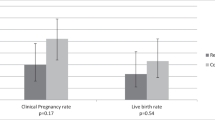Abstract
Purpose
To investigate chromosomal characteristics in the same embryos at cleavage and blastocyst stage.
Methods
Six PGD/PGS cycles were retrospective studied, including five chromosomal translocation PGD cycles and one recurrent abortion PGS cycle. The cleavage embryos were biopsied one blastomere at day 3, followed by blastocyst culture. Trophectoderm cell biopsy was performed when embryos developed into the blastocyst stage. Whole genome amplification and 24-chromosomal analysis by CGH/SNP microarray was performed on each blastomere and trophectoderm cells.
Results
After PGD/PGS, only one couple had no euploid embryos to transfer. Five couples delivered a healthy, balanced-karyotype baby. A total of 18 embryos had both blastomere and trophectoderm cell reliable results available. Of the 18 embryos, eleven embryos contained identical chromosomes from cleavage stage to blastocyst stage and six embryos contained almost identical chromosomes . Only one embryo presented opposite chromosomal results for the cleavage and blastocyst stage, with abnormal chromosomes in the blastomere but normal chromosomes in trophectoderm cells.
Conclusions
Most embryos maintain chromosomal stability during embryonic development. Compared to cleavage stage, blastocyst stage may provide more reliable aneuploidy results.



Similar content being viewed by others
References
Munné S. Chromosome abnormalities and their relationship to morphology and development of human embryos. Reprod Biomed Online. 2006;12:234–53.
Rius M, Daina G, Obradors A, Ramos L, Velilla E, Fernández S, et al. Comprehensive embryo analysis of advanced maternal age-related aneuploidies and mosaicism by short comparative genomic hybridization. Fertil Steril. 2011;95:413–6.
Treff NR, Su J, Tao X, Levy B, Scott Jr RT, et al. Accurate single cell 24 chromosome aneuploidy screening using whole genome amplification and single nucleotide polymorphism microarrays. Fertil Steril. 2010;94:2017–21.
Christopikou D, Tsorva E, Economou K, Shelley P, Davies S, Mastrominas M, et al. Polar body analysis by array comparative genomic hybridization accurately predicts aneuploidies of maternal meiotic origin in cleavage stage embryos of women of advanced maternal age. Hum Reprod. 2013;28:1426–34.
Fragouli E, Wells D, Thornhill A, Serhal P, Faed MJ, Harper JC, et al. Comparative genomic hybridization analysis of human oocytes and polar bodies. Hum Reprod. 2006;21:2319–28.
Munné S, Weier HU, Grifo J, Cohen J. Chromosome mosaicism in human embryos. Biol Reprod. 1994;51:373–9.
Wells D. Embryo aneuploidy and the role of morphological and genetic screening. Reprod Biomed Online. 2010;21:274–7.
Huang J, Yan L, Fan W, Zhao N, Zhang Y, Tang F, et al. Validation of multiple annealing and looping-based amplification cycle sequencing for 24-chromosome aneuploidy screening of cleavage-stage embryos. Fertil Steril. 2014;102:1685–91.
Mertzanidou A, Spits C, Nguyen HT, Van de Velde H, Sermon K. Evolution of aneuploidy up to Day 4 of human preimplantation development. Hum Reprod. 2013;28:1716–24.
Scott KL, Hong KH, Scott Jr RT. Selecting the optimal time to perform biopsy for preimplantation genetic testing. Fertil Steril. 2013;100:608–14.
Capalbo A, Bono S, Spizzichino L, Biricik A, Baldi M, Colamaria S, et al. Sequential comprehensive chromosome analysis on polar bodies, blastomeres and trophoblast: insights into female meiotic errors and chromosomal segregation in the preimplantation window of embryo development. Hum Reprod. 2013;28:509–18.
Fiorentino F, Spizzichino L, Bono S, Biricik A, Kokkali G, Rienzi L, et al. PGD for reciprocal and Robertsonian translocations using array comparative genomic hybridization. Hum Reprod. 2011;26:1925–35.
Gutierrez-Mateo C, Colls P, Sanchez-Garcia J, Escudero T, Prates R, Ketterson K, et al. Validation of microarray comparative genomic hybridization for comprehensive chromosome analysis of embryos. Fertil Steril. 2011;95:953–8.
Handyside AH. PGD and aneuploidy screening for 24 chromosomes by genome-wide SNP analysis: seeing the wood and the trees. Reprod Biomed Online. 2011;23:686–91.
Harton G, Braude P, Lashwood A, Schmutzler A, Traeger-Synodinos J, Wilton L, et al. ESHRE PGD consortium best practice guidelines for organization of a PGD centre for PGD/preimplantation genetic screening. Hum Reprod. 2011;26:14–24.
Bazrgar M, Gourabi H, Valojerdi MR, Yazdi PE, Baharvand H. Self-correction of chromosomal abnormalities in human preimplantation embryos and embryonic stem cells. Stem Cells Dev. 2013;22:2449–56.
Northrop LE, Treff NR, Levy B, Scott Jr RT. SNP microarray-based 24 chromosome aneuploidy screening demonstrates that cleavage-stage FISH poorly predicts aneuploidy in embryos that develop to morphologically normal blastocysts. Mol Hum Reprod. 2010;16:590–600.
Barbash-Hazan S, Frumkin T, Malcov M, Yaron Y, Cohen T, Azem F, et al. Preimplantation aneuploid embryos undergo self-correction in correlation with their developmental potential. Fertil Steril. 2009;92:890–6.
Munné S, Velilla E, Colls P, Garcia Bermudez M, Vemuri MC, Steuerwald N, et al. Self-correction of chromosomally abnormal embryos in culture and implications for stem cell production. Fertil Steril. 2005;84:1328–34.
Scott Jr RT, Ferry KM, Forman EJ, Zhao T, Treff NR. Cleavage stage biopsy significantly impairs human embryonic implantation potential whereas blastocyst biopsy does not: a randomized and paired clinical trial. Fertil Steril. 2013;100:624–30.
Kokkali G, Traeger-Synodinos J, Vrettou C, Stavrou D, Jones GM, Cram DS, et al. Blastocyst biopsy versus cleavage stage biopsy and blastocyst transfer for preimplantation genetic diagnosis of beta-thalassaemia: a pilot study. Hum Reprod. 2007;22:1443–9.
Acknowledgments
This project was supported by Peking-Tsinghua Center for Life Sciences and the National Science Foundation of China (Grant No. 81070534)
Author information
Authors and Affiliations
Corresponding author
Additional information
Capsule Most embryos maintain chromosomal stability during embryonic development. Compared to cleavage stage, blastocyst stage may provide more reliable aneuploidy results.
Rights and permissions
About this article
Cite this article
Huang, J., Zhao, N., Wang, X. et al. Chromosomal characteristics at cleavage and blastocyst stages from the same embryos. J Assist Reprod Genet 32, 781–787 (2015). https://doi.org/10.1007/s10815-015-0450-1
Received:
Accepted:
Published:
Issue Date:
DOI: https://doi.org/10.1007/s10815-015-0450-1




